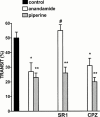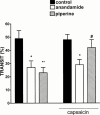Effect of vanilloid drugs on gastrointestinal transit in mice
- PMID: 11264233
- PMCID: PMC1572707
- DOI: 10.1038/sj.bjp.0703975
Effect of vanilloid drugs on gastrointestinal transit in mice
Abstract
1. We have studied the effect of capsaicin, piperine and anandamide, drugs which activate vanilloid receptors and capsazepine, a vanilloid receptor antagonist, on upper gastrointestinal motility in mice. 2. Piperine (0.5 - 20 mg kg(-1) i.p.) and anandamide (0.5 - 20 mg kg(-1) i.p.), dose-dependently delayed gastrointestinal motility, while capsaicin (up to 3 mg kg(-1) i.p.) was without effect. Capsazepine (15 mg kg(-1) i.p.) neither per se affected gastrointestinal motility nor did it counteract the inhibitory effect of both piperine (10 mg kg(-1)) and anandamide (10 mg kg(-1)). 3. A per se non effective dose of SR141716A (0.3 mg kg(-1) i.p.), a cannabinoid CB(1) receptor antagonist, counteracted the inhibitory effect of anandamide (10 mg kg(-1)) but not of piperine (10 mg kg(-1)). By contrast, the inhibitory effect of piperine (10 mg kg(-1)) but not of anandamide (10 mg kg(-1)) was strongly attenuated in capsaicin (75 mg kg(-1) in total, s.c.)-treated mice. 4. Pretreatment of mice with N(G)-nitro-L-arginine methyl ester (25 mg kg(-1) i.p.), yohimbine (1 mg kg(-1), i.p.), naloxone (2 mg kg(-1) i.p.), or hexamethonium (1 mg kg(-1) i.p.) did not modify the inhibitory effect of both piperine (10 mg kg(-1)) and anandamide (10 mg kg(-1)). 5. The present study indicates that the vanilloid ligands anandamide and piperine, but not capsaicin, can reduce upper gastrointestinal motility. The effect of piperine involves capsaicin-sensitive neurones, but not vanilloid receptors, while the effect of anandamide involves cannabinoid CB(1), but not vanilloid receptors.
Figures




Similar articles
-
Inhibitory effect of palmitoylethanolamide on gastrointestinal motility in mice.Br J Pharmacol. 2001 Nov;134(5):945-50. doi: 10.1038/sj.bjp.0704339. Br J Pharmacol. 2001. PMID: 11682441 Free PMC article.
-
Relaxant effect of capsazepine in the isolated rat ileum.Naunyn Schmiedebergs Arch Pharmacol. 2002 Mar;365(3):187-92. doi: 10.1007/s00210-001-0522-x. Epub 2002 Feb 1. Naunyn Schmiedebergs Arch Pharmacol. 2002. PMID: 11882914
-
Effect of piperine, the active ingredient of black pepper, on intestinal secretion in mice.Life Sci. 2002 Sep 27;71(19):2311-7. doi: 10.1016/s0024-3205(02)02019-2. Life Sci. 2002. PMID: 12215378
-
Cardiovascular pharmacology of anandamide.Prostaglandins Leukot Essent Fatty Acids. 2002 Feb-Mar;66(2-3):343-51. doi: 10.1054/plef.2001.0346. Prostaglandins Leukot Essent Fatty Acids. 2002. PMID: 12052048 Review.
-
Endocannabinoids and the gut.Prostaglandins Leukot Essent Fatty Acids. 2002 Feb-Mar;66(2-3):333-41. doi: 10.1054/plef.2001.0345. Prostaglandins Leukot Essent Fatty Acids. 2002. PMID: 12052047 Review.
Cited by
-
Role of intrinsic nitrergic neurones on vagally mediated striated muscle contractions in the hamster oesophagus.J Physiol. 2003 Aug 15;551(Pt 1):287-94. doi: 10.1113/jphysiol.2003.044669. Epub 2003 Jun 17. J Physiol. 2003. PMID: 12813149 Free PMC article.
-
The role of endocannabinoids in the regulation of gastric emptying: alterations in mice fed a high-fat diet.Br J Pharmacol. 2008 Mar;153(6):1272-80. doi: 10.1038/sj.bjp.0707682. Epub 2008 Jan 28. Br J Pharmacol. 2008. PMID: 18223666 Free PMC article.
-
Inhibitory effect of palmitoylethanolamide on gastrointestinal motility in mice.Br J Pharmacol. 2001 Nov;134(5):945-50. doi: 10.1038/sj.bjp.0704339. Br J Pharmacol. 2001. PMID: 11682441 Free PMC article.
-
Investigation on the relationship between cannabinoid CB1 and opioid receptors in gastrointestinal motility in mice.Br J Pharmacol. 2006 Aug;148(8):1043-50. doi: 10.1038/sj.bjp.0706824. Epub 2006 Jul 17. Br J Pharmacol. 2006. PMID: 16847440 Free PMC article.
-
Effects of piperine, the pungent component of black pepper, at the human vanilloid receptor (TRPV1).Br J Pharmacol. 2005 Mar;144(6):781-90. doi: 10.1038/sj.bjp.0706040. Br J Pharmacol. 2005. PMID: 15685214 Free PMC article.
References
-
- ABDEL SALAM O.M., SZOLCSANYI J., PORSZASZ R., MOZSIK G. Effect of capsaicin and resiniferatoxin on gastrointestinal blood flow in rats. Eur. J. Pharmacol. 1996;305:127–136. - PubMed
-
- ALLESCER H.-D., SATTLER D., PILLER C., SCHUSDZIARRA V., CLASSEN M. Ascending neural pathways in the rat ileum in vitro: effect of capsaicin and involvement of nitric oxide. Eur. J. Pharmacol. 1992;217:153–162. - PubMed
-
- BARTHO' L., HOLZER P. The inhibitory modulation of guinea-pig intestinal peristalsis caused by capsaicin involves calcitonin gene-related peptide and nitric oxide. Naunyn-Schmiedeberg's Arch. Pharmacol. 1995;353:102–109. - PubMed
Publication types
MeSH terms
Substances
LinkOut - more resources
Full Text Sources
Other Literature Sources

